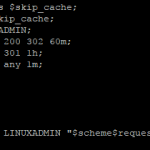
Percona Xtrabackup can be used to create “hot backups” of MySQL servers fairly quickly and can avoid some of the pitfalls of mysqldump. Xtrabackup can be setup to use backup locks instead of read locks which is much less invasive, this is available on innodb tables. MyISAM and other tables will still need to be read locked to perform a backup. Xtrabackup will work on MySQL, MariaDB and Percona (versions 5.1, 5.5, 5.6, 5.7). You can then use this backup to easily replicate the MySQL slave. This guide assumes you already have a running SQL server and CentOS.
Install Percona Xtrabackup
First you want to install the repository, you can get additional repositories from Percona‘s site
yum install -y http://www.percona.com/downloads/percona-release/redhat/0.1-4/percona-release-0.1-4.noarch.rpm
Then install Percona Xtrabackup
yum install -y percona-xtrabackup-24
Install rsync as well as we will use this to transfer the backup to the slave
yum install -y rsync
Create A Backup with Xtrabackup
First you will want to create a initial backup with innobackupex
innobackupex /root/percona-backup
Replace /root/percona-backup with path if you need to. If you need to specify a user and password use the following flags
innobackupex --user=username --password=passwordhere /root/percona-backup
When it starts you should see the following message
innobackupex: Starting the backup operation
Upon completion you should see the following
xtrabackup: Transaction log of lsn (1597945) to (1597945) was copied. 170810 21:37:19 completed OK!
If you look in the /root/percona-backup directory you set, you will see a time-stamp directory, this is the SQL backup
# ls /root/percona-backup/ 2017-08-10_21-37-17
You will now need to apply the transaction log to the backup by performing the following
innobackupex ---apply-log /root/percona-backup/2017-08-10_21-37-17
You will again be looking for the ‘OK’ message at the end of the program
xtrabackup: The latest check point (for incremental): '1597945' xtrabackup: Stopping log copying thread. .170810 21:44:58 >> log scanned up to (1597945) 170810 21:44:58 Executing UNLOCK TABLES 170810 21:44:58 All tables unlocked 170810 21:44:58 Backup created in directory '/root/percona-backup/2017-08-10_21-37-17/2017-08-10_21-44-56/' 170810 21:44:58 [00] Writing /root/percona-backup/2017-08-10_21-37-17/2017-08-10_21-44-56/backup-my.cnf 170810 21:44:58 [00] ...done 170810 21:44:58 [00] Writing /root/percona-backup/2017-08-10_21-37-17/2017-08-10_21-44-56/xtrabackup_info 170810 21:44:58 [00] ...done xtrabackup: Transaction log of lsn (1597945) to (1597945) was copied. 170810 21:44:59 completed OK!
Prepare the SQL Master
On the master server, if it is not already prepared for slaves, you will want to get it ready. You will want to make sure a bin log is configured in my.cnf
nano /etc/my.cnf
Add the following
log_bin = /var/log/mysql/mysql-bin.logAlso set a server-id in /etc/my.cnf
server-id = 1The server-id can be any number it just needs to be unique on each server in the replication.
You will need to restart MySQL for it to take affect
systemctl restart mysql
You will also want to ensure the firewall is open for the port 3306
firewall-cmd --zone=public --add-service=mysql --permanent
firewall-cmd --zone=public --add-port=3306/tcp --permanentThen reload the firewall
firewall-cmd --reload
Prepare the SQL Slave
You will want to add a server-id to /etc/my.cnf on the slave
server-id=2
You will also want to open the same port in the firewall as you did the on the master. Since we are copying the entire Xtrabackup you can go ahead and shutdown MySQL on the Slave
systemctl stop mysql
Go ahead and make a backup of /var/lib/mysql incase something goes wrong
cp -R /var/lib/mysql /var/lib/mysql.bak
You will also want to ensure the firewall is open for the port 3306 on the slave as well
firewall-cmd --zone=public --add-service=mysql --permanent
firewall-cmd --zone=public --add-port=3306/tcp --permanentThen reload the firewall
firewall-cmd --reload
Configure MySQL Replication
Sync the backup from the master to the slave
rsync -vPa /root/percona-backup/2017-08-10_21-37-17 192.168.1.100:/var/lib/mysql
You will want to replace the path with the updated path to your backup and the 192.168.1.100 ip address with IP address of your slave.
Once the rsync has finished you will want to change the permissions of /var/lib/mysql to be owned by the slave
chown -R mysql. /var/lib/mysql
On the master enter the mysql console:
mysql
Grant permissions for replication to the slave
grant replication slave on *.* to [email protected] identified by 'password';
You will want to change the replicationuser to a desired user name, 192.168.1.100 to the IP address of the slave and password to your desired password.
Then flush privileges on the master
flush privileges;
Start The MySQL Slave
On the slave you will need to gather the needed slave information so
cat /var/lib/mysql/xtrabackup_binlog_info mysql-bin.000001 245
This contains the MASTER_LOG_FILE and MASTER_LOG_POS information you will need to enter in MySQL to connect to the master
Connect to MySQL on the slave
mysql -uroot -p
Enter the following information
CHANGE MASTER TO MASTER_HOST='192.168.1.101', MASTER_USER='replicationuser', MASTER_PASSWORD='password', MASTER_LOG_FILE='mysql-bin.000001', MASTER_LOG_POS= 245;
MASTER_HOST will be the IP address of the MySQL master.
MASTER_USER will be the replicationuser you set earlier on the master.
MASTER_PASSWORD will be the password you configured earlier on the master.
MASTER_LOG_FILE and MASTER_LOG_POS will be obtained from the xtrabackup_binlog you viewed earlier
Once you have added that information in MySQL you should see the following
MariaDB [(none)]> CHANGE MASTER TO MASTER_HOST='192.168.1.101', -> MASTER_USER='replicationuser', -> MASTER_PASSWORD='password', -> MASTER_LOG_FILE='mysql-bin.000001', -> MASTER_LOG_POS= 245; Query OK, 0 rows affected (0.04 sec)
You can go ahead and start slaving now:
start slave;
To check slave status perform type show slave status;
MariaDB [(none)]> show slave status\G; *************************** 1. row *************************** Slave_IO_State: Waiting for master to send event Master_Host: 192.168.1.101 Master_User: replicationuser Master_Port: 3306 Connect_Retry: 60 Master_Log_File: mysql-bin.000001 Read_Master_Log_Pos: 483 Relay_Log_File: mariadb-relay-bin.000002 Relay_Log_Pos: 767 Relay_Master_Log_File: mysql-bin.000001 Slave_IO_Running: Yes Slave_SQL_Running: Yes Replicate_Do_DB: Replicate_Ignore_DB: Replicate_Do_Table: Replicate_Ignore_Table: Replicate_Wild_Do_Table: Replicate_Wild_Ignore_Table: Last_Errno: 0 Last_Error: Skip_Counter: 0 Exec_Master_Log_Pos: 483 Relay_Log_Space: 1063 Until_Condition: None Until_Log_File: Until_Log_Pos: 0 Master_SSL_Allowed: No Master_SSL_CA_File: Master_SSL_CA_Path: Master_SSL_Cert: Master_SSL_Cipher: Master_SSL_Key: Seconds_Behind_Master: 0 Master_SSL_Verify_Server_Cert: No Last_IO_Errno: 0 Last_IO_Error: Last_SQL_Errno: 0 Last_SQL_Error: Replicate_Ignore_Server_Ids: Master_Server_Id: 1 1 row in set (0.00 sec)
The specific lines you are looking for to ensure replication is working are
Slave_IO_Running: Yes Slave_SQL_Running: Yes
That is all that is needed for creating MySQL replication with Perconna Xtrabackup.




yes this is working for me thank
Glad to hear it!